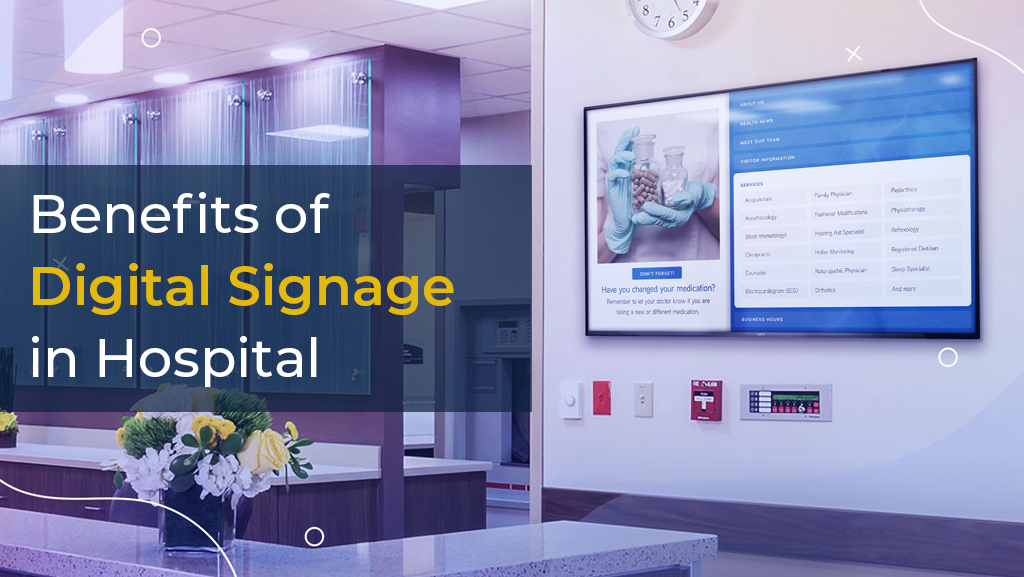The Benefits of Implementing Digital Signage in Hospitals
The healthcare sector is not an exception when it comes to accepting novel solutions in an age marked by technological breakthroughs. Digital signage is one such approach that has gained popularity in medical facilities all around the world. The patient experience is changing thanks to the adoption of digital signage systems in healthcare institutions, which are also reducing processes and improving communication. We’ll look at the many advantages of using digital signage in hospitals in this blog article, as well as how it’s changing the face of healthcare.
1: Enhanced Patient Experience
1.1 Real-time Information Accessibility:
Patients get immediate access to vital information thanks to digital signs in hospitals. Patients can simply traverse the complicated hospital environment and keep up with their schedules thanks to navigation maps and appointment reminders, which lessens anxiety and confusion.
1.2 Personalized Patient Education:
Hospitals may inform patients about their diseases, available treatments, and preventative care alternatives by using customized material on digital screens. Access to instructional films and resources enables patients to participate actively in their treatment.
2: Improved Communication
2.1 Efficient Staff Communication:
Digital signage serves as an efficient tool for communicating with hospital staff. Messages, announcements, and updates can be disseminated quickly, ensuring that all staff members are informed, reducing communication gaps, and improving overall efficiency.
2.2 Emergency Alerts and Notifications:
During emergencies, such as fires or lockdowns, digital signage can deliver instant alerts and instructions to both staff and patients, helping to maintain safety and order within the hospital premises.
3: Streamlined Operations
3.1 Reduced Wait Times:
Digital signage systems can display real-time information about appointment delays, enabling patients to make informed decisions about their time. This helps hospitals manage patient flow more effectively, minimizing wait times.
3.2 Queue Management:
Hospitals can use digital signage to implement queue management systems. Patients can check-in digitally, receive a queue number, and track their position in the queue, reducing congestion in waiting areas.
4: Cost Savings
4.1 Paperless Environment:
Digital signage reduces the need for printed materials like brochures, pamphlets, and posters. This not only saves on printing costs but also contributes to a more eco-friendly and sustainable healthcare environment.
4.2 Energy Efficiency:
Modern digital signage solutions are energy-efficient and can be programmed to power down during non-operational hours. This leads to significant energy savings for hospitals in the long run.
5: Compliance and Information Accuracy
5.1 Compliance with Regulations:
Digital signage ensures that hospitals can easily update and maintain compliance with changing regulations and guidelines, such as COVID-19 safety protocols and information.
5.2 Accurate Information Dissemination:
With digital signage, hospitals can swiftly update information across all screens, reducing the risk of outdated or incorrect information being displayed to patients, visitors, and staff.
6: Promoting Hospital Services
6.1 Marketing and Branding:
Digital signage can be used to promote hospital services, departments, and specialties. Hospitals can showcase their expertise, innovations, and achievements, helping to build trust and attract patients.
6.2 Community Engagement:
Hospitals can use digital signage to engage with the community by displaying health awareness campaigns, wellness tips, and local healthcare initiatives, thereby fostering a sense of community well-being.
Conclusion:
The adoption of digital signage in hospitals is reshaping the healthcare landscape by enhancing the patient experience, improving communication, streamlining operations, reducing costs, ensuring compliance, and promoting hospital services. As technology continues to evolve, we can expect digital signage to play an even more significant role in revolutionizing healthcare, ultimately leading to better patient outcomes and satisfaction. It’s clear that digital signage is not just a trend but an essential tool for modern hospitals striving to provide high-quality care in a dynamic and ever-changing healthcare environment.







